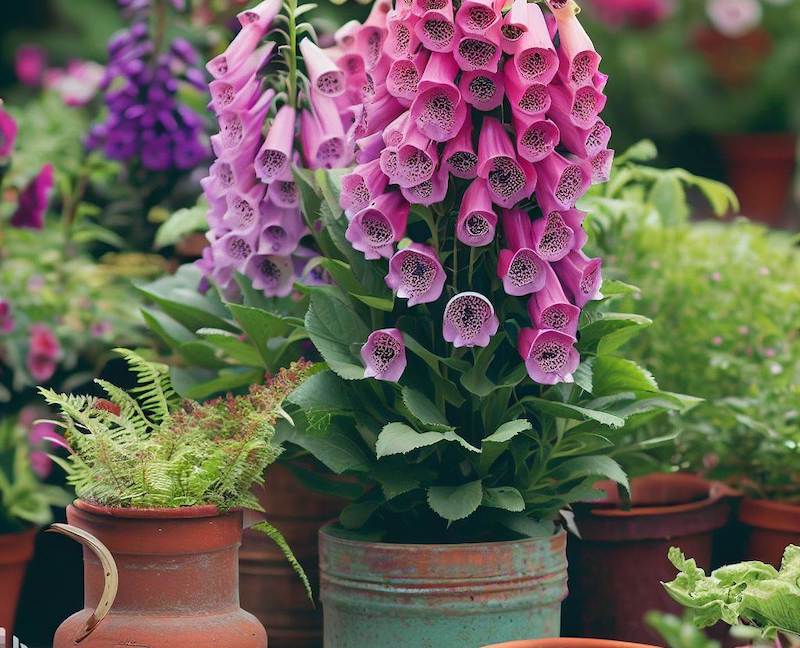Foxgloves of all types can be successfully grown in pots as part of a container garden or in larger planters as part of a mixed seasonal color planting. The biennial Digitalis purpurea can add dramatic height to a large planting. The shorter-growing perennial varieties can be used as a filler plant to add a colorful backdrop for other flowering container plants. Foxglove in containers can be used to decorate a deck, patio, or entryway as well as fill in blank spots in a garden border. The advantage of containers is being able to place the plants without having to worry about transplanting self-sown seedlings.

Planting Foxglove in Pots
Foxglove seedlings, either biennial or perennial, spend the first year growing foliage and a root system before blooming the following year. This immature stage is the best time to pot up seedlings for future container displays. The seedlings will readily establish in a pot where they can be grown for one or more years. Because most Foxgloves tend to have tall flower spikes and can be top-heavy, always use a pot with a wide and heavy base. Choose a location that has partial shade or dappled sun exposure to ensure a good display of flowers. The pot must have good drainage to ensure the root system does not sit in soggy soil at any time of the year.
Best Soil For Foxglove in Pots
Choose an all-purpose potting mix that is peat-free. There is no need to use specialized soil for acid-loving plants. Foxglove will grow in neutral potting soils fine and can be supplemented with a fertilizer for acid-loving plants if it shows signs of mineral deficiency. Ensure the pot drainage is excellent year-round since these plants will be grown for two or more years in the same position. The hardy biennial foxglove can be fairly drought tolerant when grown in a garden border, but those same plants growing in a container will need to have consistently moist soil. Adding a 1-2 inch layer of finely shredded arborist chips, leaves, or compost as a mulch helps cool the roots and retain moisture in the soil longer.
Caring For Foxglove in Planters
Container gardening generally requires more attention to regular watering and fertilizing. Container plants rely on the gardener for replenishing nutrients that are regularly leached from the soil through watering. The soil also dries out more quickly in containers than in the garden, so potted Foxglove will need to be watered more frequently.
Watering Foxglove in Pots
Foxglove flourishes and blooms best in soils that are consistently moist and well draining. Allowing the top 2-3 inches of potting soil to dry between waterings ensures the plants are neither over- nor under-watered. During periods of dry weather, supplemental watering will be essential. Water pots thoroughly until water flows from the bottom drainage holes. This lets you know that all of the soil has been saturated.
Fertilizing Foxglove in Pots
Foxgloves in a container will need to be regularly fertilized, even though they require little extra nutrition when grown in a garden border. Choose a water-soluble fertilizer that can be applied in place of watering. Dr. Earth liquid Total Advantage Rose and Flower fertilizer is a great choice to support heavy blooming and strong overall plant growth. Apply the fertilizer according to the manufacturer's recommendations, from early spring until blooming ends in early summer.
Winter Care For Foxglove in Pots
Foxglove grown in containers through the winter may require some extra measures to ensure its success. Using weather-resistant pots is important. Select a wood, resin, metal, or fiberglass container in the coldest growing zones. Ceramic, terra cotta and plastic pots are better suited for year-round growing in warmer climates where there is less risk of the material freezing and cracking, flaking, or breaking.
Growing Foxglove Indoors
Foxglove does not make a good houseplant. It requires a period of dormancy and cold exposure to grow and bloom well in the second year. The seedlings can be grown for the first year in an unheated greenhouse or on a bright window sill in a cool room. The seedlings should be transplanted outdoors by late summer or early fall in preparation for blooming the following year.
 |
Author Robbin Small - Published 6-28-2023 |
